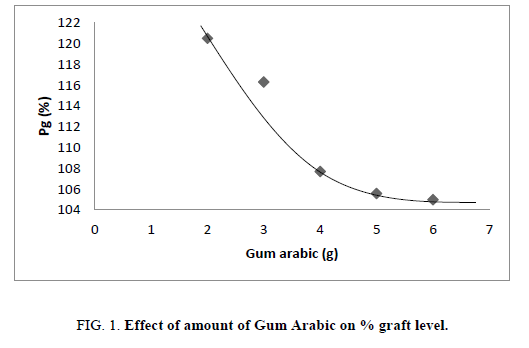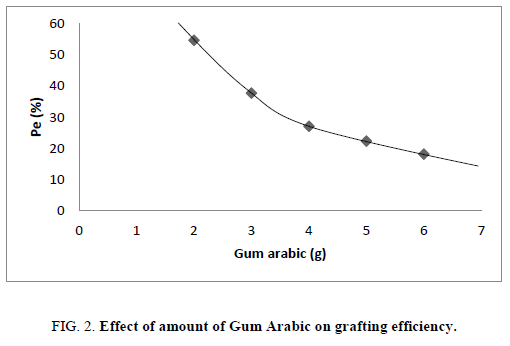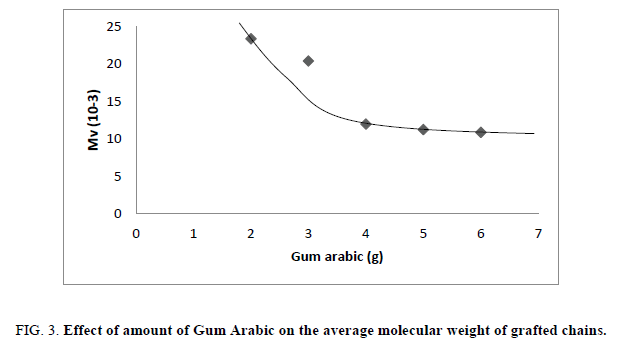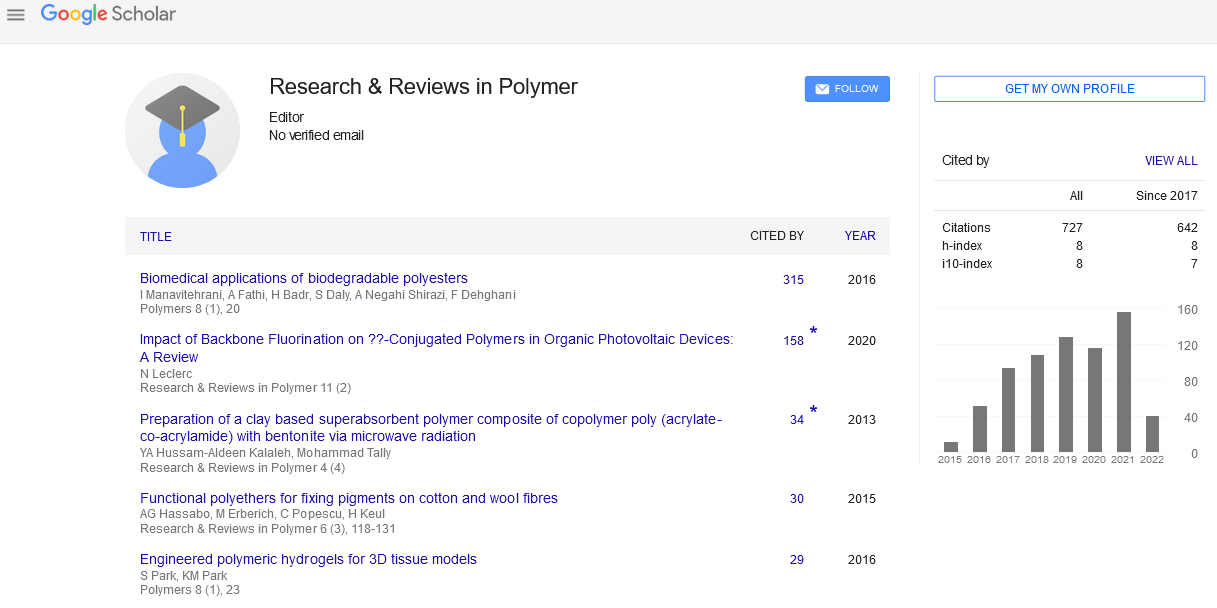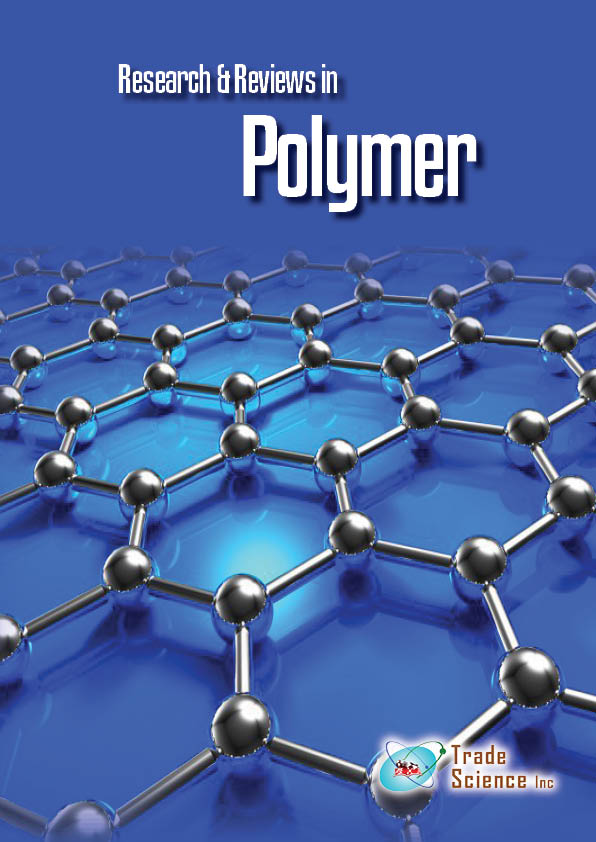Original Article
, Volume: 7( 3)Graft Copolymerization of Vinyl Acetate on Gum Arabic. Effect of Amount of Substrate
- *Correspondence:
- Inegbedion F , Department of Polymer Technology, Auchi Polytechnic, Auchi, Edo State; E-mail:festusinegbedion@yahoo.com
Received: June 24, 2016; Accepted: July 30, 2016; Published: July 31, 2016
Citation: Inegbedion F, Okojie VU, Egharevba F. Graft Copolymerization of Vinyl Acetate on Gum Arabic. Effect of Amount of Substrate. Res Rev Polym. 2016;7(3):103.
Abstract
The graft copolymerization of vinyl acetate onto Gum Arabic in aqueous medium was studied using benzoyl peroxide in the presence of polyvinyl alcohol. The effect of amount of substrate (Gum Arabic) over the range 2 g to 6 g was investigated. It was found that the graft level and grafting efficiency decreases with increase in the amount of substrate. This indicates that a low number of grafting sites may have been created on the substrate.
Keywords
Copolymerization; Gum arabic; Grafting; Vinyl acetate; Polyvinyl alcohol
Introduction
Graft copolymerization provides a unique technique for modifying polymers to meet desired use requirements. Graft copolymers of polysaccharides are of additional interest because of their potentials as enhanced viscosities in secondary petroleum recovery processes, and as flocculants in mining and wastewater treatments [1]. Graft copolymerization of vinyl monomers is one of the universal effective and accessible methods for the chemical modification of natural polymers [2].
An important advantage of graft copolymerization is that the polymeric substrate or backbone polymer and the grafted polymer chains are held together by chemical bonding allowing the two polymers to be intimately associated rather than as mere physical mixture. Thermodynamically, the grafted chains are expected to be distributed on the backbone polymer and impact beneficial effects on the properties of the composite. In fact, the chemical, physical, mechanical and rheological properties of graft polymers correlate well with the size and distribution pattern of the grafted backbone polymer [3]. Thus a major focus in graft copolymerization studies is the optimization of grafting frequency i.e., the number of polymer grafts introduced on the backbone polymer [3].
Graft copolymers are becoming more important as an alternative to totally new linear polymers and copolymers, as the ability to synthesize polymers of any quality from readily available and reasonably in-expensive monomers is very attractive industrially [4]. Grafting yield copolymers with remarkable changes in physiochemical properties with industrial and commercial values [5-12].
Gum Arabic which is essentially a complex polysaccharide is a natural gum made of hardened sap taken from species of the acacia tree. It is harvested commercially throughout the Sahel from Senegal and Sudan to Somalia and also in the northern part of Nigeria [13]. Gum Arabic is useful as hydrocolloid, emulsifier, texturizer and film-former [14].
Benzoyl peroxide is often used in homopolymerization especially in suspension and emulsion polymerization. The effect of initiator concentration [15] and monomer concentration [16] on the graft level and grafting efficiency has been studied. The present study is on the graft copolymerization of vinyl acetate on Gum Arabic. The effect of amount of substrate on the graft level and grafting efficiency was investigated and discussed.
Materials and Methods
Gum Arabic was purchased from Kano market in Kano. It was purified by dissolving in deionized water for three days, filtered and precipitated in excess isopropanol and dried in vacuum desiccator.
Vinyl acetate monomer and benzoyl peroxide were obtained from Qualikems Fine Chemicals Ltd. All other reagents, that is, isopropanol (Sigma Aldrichinc), methanol (Sigma Aldrichinc), polyvinyl alcohol (BDH Ltd.), acetic acid (BDH Ltd.), sulphuric acid (Sigma Aldrichinc), hydrochloric acid (BDH Ltd.) and sodium hydroxide (Chemproha Chemical) were used as supplied.
Grafting procedure
The effect of amount of substrate was determined using various amounts of gum Arabic and constant amounts of benzoyl peroxide and vinyl acetate. The Gum Arabic (2, 3, 4, 5 and 6 g) respectively for the different sets of the experiment was dispersed in 20 ml of deionized water in a beaker. The required amount of polyvinyl alcohol (4.53 mol/L) was introduced into the beaker. The beaker was placed in a water bath and heated at a temperature of 70°C. The required amount of benzoyl peroxide (0.02 M) was added to vinyl acetate (4.88 mol/L) in a test tube and the reaction was allowed to proceed for 30 min in a water bath at a temperature of 70°C. The benzoyl peroxide/vinyl acetate was then added to the beaker containing Gum Arabic/polyvinyl alcohol at 70°C and the polymerization reaction was allowed to proceed with agitation for 2 h. The reaction mixture was poured into excess isopropanol (150 cm3) to precipitate the total polymer. It was filtered and dried in air.
The ungrafted polyvinyl acetate homopolymer formed was extracted with 1:1 acetic acid and water. The residue obtained was air-dried and weighed. The weight of the homopolymer was therefore reported as weight of total polymer minus weight of grafted polymer and weight of Gum Arabic.
The percentage graft level, Pg, is reported as the weight of the grafted polymer, divided by the weight of the Gum Arabic used multiplied by 100 [17].

Where W1 and W2 are the weights of the Gum Arabic and grafted polymer respectively.
The grafting efficiency, Pe, is reported as weight of grafted polymer divided by the weight of synthesized polymer formed (weight of grafted polymer and weight of homopolymer) multiplied by 100 [17].

Isolation and molecular weight determination of grafted polymer chains
The grafted polymer chains were isolated from the backbone polymer by treatment with 5 ml dilute sulphuric acid for 24 h at room temperature. The mixture was poured into excess methanol (100 cm3) and the grafted polymer precipitated was dried overnight. The isolated polymer was dissolved in acetone and the average molecular weight was determined from viscosity measurement in acetone at 25°C using Mark-Houwink equation.
η=KMva
Where η is the intrinsic viscosity of the polymer, Mv is the average molecular weight, K and ‘a’ are empirical (Mark-Houwink) constants that are specific for a given polymer, solvent and temperature.
Results and Discussion
The graft level (Figure. 1), grafting efficiency (Figure. 2), molecular weight of grafted chains (Figure. 3) were found to decrease with increase in the amount of Gum Arabic (Table 1).
Figure 2: Effect of amount of Gum Arabic on grafting efficiency.
| Gum Arabic (g) | % graft level | Grafting efficiency (%) | Mv of grafted chains 10-3 |
|---|---|---|---|
| 2.00 | 120.50 | 54.64 | 23.34 |
| 3.00 | 116.30 | 37.73 | 20.38 |
| 4.00 | 107.70 | 27.10 | 11.97 |
| 5.00 | 105.60 | 22.37 | 11.25 |
| 6.00 | 105.00 | 18.18 | 10.87 |
Table 1: Variation of amount of substrate.
This may be due to the low number of grafting site created on the substrate because of the increased amount of gum compared to a fixed concentration of the initiator.
Conclusion
The graft copolymerization of vinyl acetate on Gum Arabic using benzoyl peroxide was presented in this article. Benzoyl peroxide can successfully initiate graft copolymerization of vinyl acetate onto Gum Arabic. The effect of amount of substrate was investigated and discussed. It was found that the graft level and grafting efficiency decreases with increased amount of substrate. The decrease may be due to the low number of grafting site created on the substrate because of the increased amount of gum compared to a fixed concentration of initiator.
References
- Hebish A, Gutherie J. The chemistry and technology of cellulose copolymers. Berlin: Spring Verlag;1981. 25 p.
- Ghosh P, Ganguly PK. Polycarylonitrile [pan] grafted jute fibers. Some physical and chemical properties and morphology. J Apl Polym Sci. 1994;52:72-8.
- Pledge HJR, Butler GB, Young TS, et al. Acrylamide grafting to yellow dextrin. J Macromol Sci Chem. 1985;22(9):1297-307.
- Nwufo BT, Ibrahim I. Graft copolymerization of acrylonitrile on kenaf fibers using ferric ion toluene redox pair. J Polym Sci Tech. 2000;2:63-8.
- Thejappa N, Pandey SN. Grafting of hydrophobic styrene monomer onto cotton fibers. J Apl Polym Sci. 1982;27:2307-15.
- McDowall DJ, Grupta BS, Stannett YT. Grafting of vinyl monomers onto cellulose by ceric ion initiation. Prog Polym Sci. 1984;10(1):1-85.
- Das H, Noyak NC, Singh BC. Graft copolymerization of methylmethacrylate onto jute fibers. J Macromol Sci Chem. 1991;28(3-4):287.
- Okiemen FE. Graft copolymers of partially hydrolysed starch and acrylonitrile. Preparation and testing as flocculating agents. J Polym Sci Tech. 2000;2:125-9.
- Ighodalo CE, Matudi LS. Graft copolymerization of acrylonitrile on caesarweed fibers by ceric ion in the presence of isobutylalcohol. J Polym Sci Tech. 2000;2:30-3.
- Egharevba F, Ikidi OO. The nature of grafted chains and radical termination in graft copolymerization of ethyl acrylate on dilute solutions of dextrin. BullSci Assoc Nigeria. 1997;21:45-8.
- Egharevba F,Okieimen FE. A comparative study on the graft copolymerization of acrylate monomers on starch and dextrin. Discov Innovat. 2000;12(3/4):142-6.
- Egharevba F, Esimaghele T. Grafting characteristics, chain termination and the role of ?monomer complex? in graft copolymerization of ethyl acrylate on dilute solutions of dextrin. Jamaican J Sci Tech.1999;10:79-85.
- Smolinske SC. Handbook of food, drug and cosmetic excipients. 1sted. Florida: CRC Press;1992.
- Philip GO, Ogasawara T, Ushida K. The regulatory and scientific approach to defining gum arabic as a dietary fiber. Food Hydrocoll. 2007;22(1):24-35.
- Inegbedion F, Okojie VU, Egharevba F. Graft copolymerization of vinyl acetate on gum arabic. Res Rev Polym. 2014;5(1):14-8.
- Inegbedion F, Okojie VU, Egharevba F. Graft copolymerization of vinyl acetate on gum arabic. Effect of monomer concentration. Mater Sci Ind J. 2015;12(1):1-4.
- Ogbeifun DE, Okieimen FE, Okuo JM. Grafting of n, n-dimethylacrylamide on gum arabic. J Chem Soc Nigeria. 2011;36(1):15-9.
